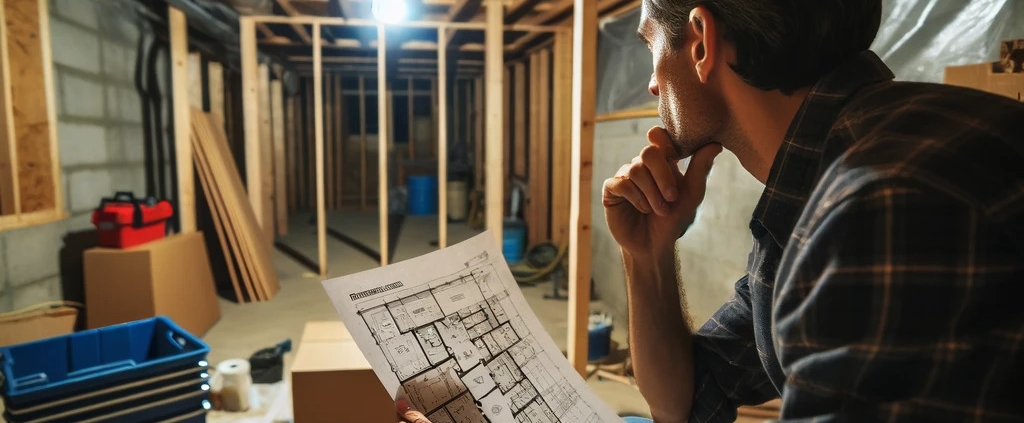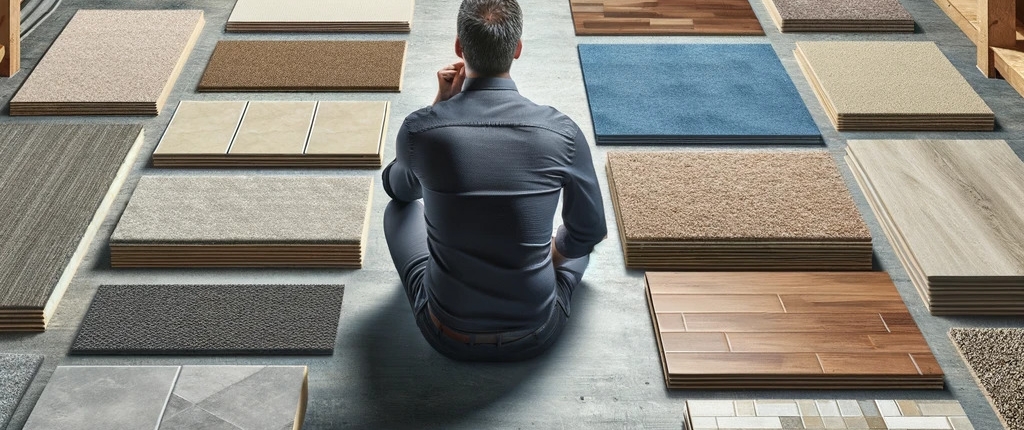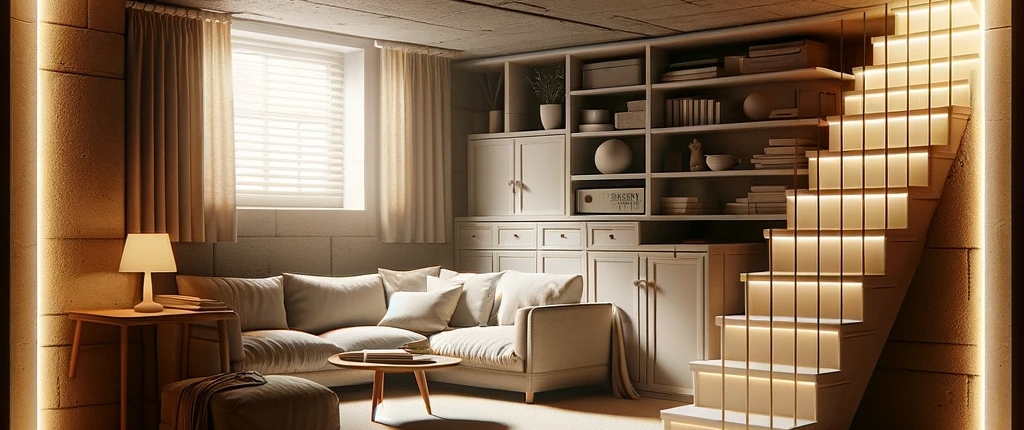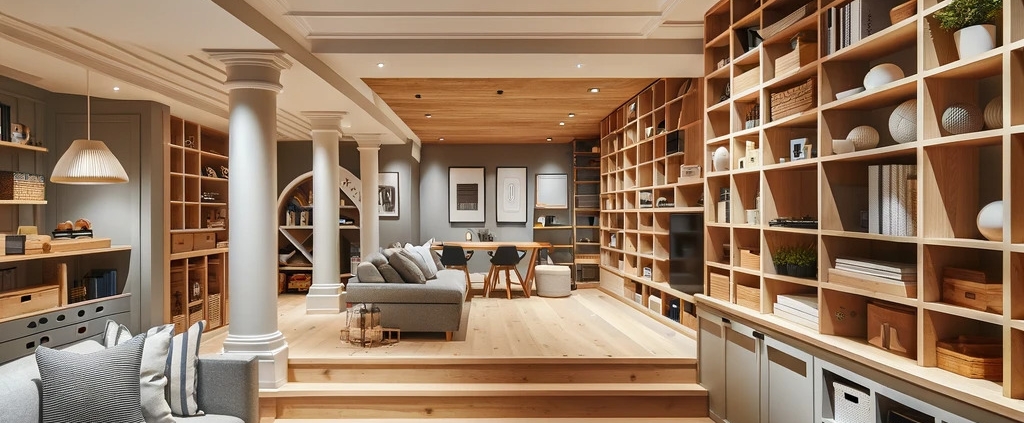What Basement Finishing Actually Means
If your basement looks more like a storage locker than a living space, finishing it can change everything. Basement finishing means turning a rough, exposed space—concrete floors, open ceilings, mystery wires—into something warm, livable, and actually useful.
That could be a home office, guest suite, workout space, income unit… or just somewhere to send the kids when they’re bouncing off the walls upstairs.
The process typically includes:
- Moisture check and prep
- Framing and insulation
- Electrical and plumbing
- Walls, floors, and ceilings
- Fixtures, lighting, storage, and décor
For the full process breakdown, start here: basement remodeling
Why Finish Your Basement?
Besides rescuing it from cobwebs and cardboard boxes, here’s what basement finishing gives you:
- More living space without adding an addition
- Increased property value—finished basements sell homes faster
- Customization—design it around your life, not your leftover furniture
- Better energy efficiency, especially with proper insulation
- A chance to fix existing issues like leaks, mold, or bad framing
Need ideas? Head over to Renovation Ideas.
Start with a Plan
Every successful basement makeover begins with a clear plan and a realistic budget.
Define Your Goal
What do you want this space to be? A rental suite? A gym? A game room with mood lighting and no judgment? Define how you’ll use it—that’ll guide everything else.
See some creative layouts here: Basement Renovation Design
Build a Budget
Know your limits before the demo starts. Include:
- Materials
- Labour
- Permits and inspections
- Contingency (10–20% for surprises—because there will be surprises)
| Expense Category | Estimated Cost |
|---|---|
| Materials | $ |
| Labour | $ |
| Permits & Inspections | $ |
| Contingency | $ |
| Total | $ |
Use this guide for reference: Basement Renovation Cost
Understand the Process
Here’s how the renovation usually unfolds:

1. Inspection & Prep
Check for moisture, mold, pests, and cracks. Clear out everything—even that dusty treadmill you haven’t used since 2018.
2. Framing & Insulation
Frame your layout, add insulation, and seal the space up tight. Compare insulation types:
| Type | Pros | Cons |
|---|---|---|
| Fiberglass | Affordable, easy to install | Not waterproof, skin irritant |
| Spray Foam | Seals tight, moisture-resistant | Costlier |
| Rockwool | Fireproof, sound-dampening | Dense, harder to cut |
3. Electrical & Plumbing
Unless you’re certified, leave this part to pros. That includes lighting, outlets, switches, water lines, and drainage.
Choosing Your Layout
Big question: Open concept or divided rooms?
| Layout Style | Pros | Cons |
|---|---|---|
| Open Concept | Airy, flexible | Less privacy, more echo |
| Divided Spaces | Private, multi-use | Can feel tighter, costlier |
Match the layout to how you’ll use the space—yoga doesn’t pair well with drum kits.
If you need inspiration, our basement renovation ideas might help spark your imagination.
Need layout examples? Check out our basement renovation design article.
Basement Flooring Options
Your floor needs to stand up to moisture, temperature swings, and foot traffic. Here’s what to consider:

Concrete Flooring
| Pros | Cons |
|---|---|
| Durable and long-lasting | Can feel cold and hard underfoot |
| Resistant to moisture | Limited design options |
| Easy to clean | May require professional installation |
Vinyl Flooring
| Pros | Cons |
|---|---|
| Waterproof and resistant to humidity | Can be damaged by sharp objects |
| Easy to install and maintain | Lower quality options may look cheap |
| Wide variety of designs | Not as eco-friendly as other options |
Ceramic Tile
| Pros | Cons |
|---|---|
| Extremely durable | Can feel cold and hard underfoot |
| Water and stain-resistant | Installation can be complex |
| Wide variety of designs | Grout lines can be hard to clean |
Carpet
| Pros | Cons |
|---|---|
| Warm and comfortable underfoot | Not suitable for damp basements |
| Variety of styles and colors | Can be difficult to clean |
| Can help reduce noise | May require professional installation |
Remember, the best flooring for your basement depends on the use of the space, your budget, and personal preference.
For more tips and ideas on basement remodeling, check out our articles on basement renovation ideas and basement renovation design.
Wall & Ceiling Finishes
No one can tell you which is better, it all depends on your usage, preferences, budget and basement state, take your pick:
Walls:
- Drywall: Clean, paintable finish. Great if you’ve addressed moisture issues.
- Paneling: Faster install, lower cost. Some love it, some say it feels like grandma’s rec room.
Ceilings:
- Drywall ceiling: Cleanest look, harder to access utilities
- Drop ceiling: Practical and accessible, but not everyone loves the vibe
- Painted open joists: Industrial, budget-friendly—but less soundproof
Other Must-Knows
Here are a few essential tips you’ll want to keep in mind to avoid common pitfalls and ensure your new space is practical, comfortable, and enjoyable:


